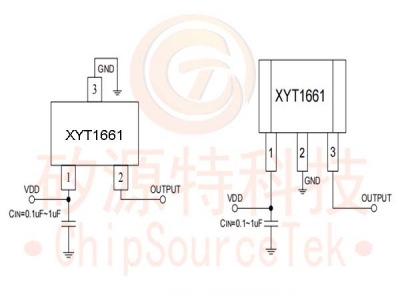XYT1661 Description/概述:
The XYT1661 Omnipolar Hall effect sensor IC is fabricated from mixed signal CMOS technology. It is comprised of two Hall plates and a CMOS output driver,mainly designed for battery-operation. The total power consumption in normal operation is typically 3.6μW with a 1.8V power source. either north or south poles of sufficient strength will turn the output on. The output will be turned off under no magnetic field. While the magnetic flux density (B) is larger than operating point (BOP), the output will be turned on (low), the output is held until B is lower than release point (BRP), and then turned off.
The XYT1661 is available in many flexible packaging options, such as SOT23-3L/SIP-3L. Operating temperature range of the XYT1661 is from -40°C to 85°C.
XYT1661全極性霍爾效應傳感器集成電路是由混合信號CMOS技術(shù)制造的。它由兩個霍爾板和一個CMOS輸出驅(qū)動器組成,主要設計用于電池操作。正常運行時的總功耗一般為3.6μW,電源為1.8V。有足夠強度的北極或南極都能打開輸出。輸出將在無磁場條件下關閉。當磁通密度(B)大于工作點(BOP)時,輸出打開(低),保持至B低于釋放點(BRP),然后關閉。
XYT1661有許多軟包裝選項,如SOT23-3L/SIP-3L。XYT1661的工作溫度范圍為-40°C到85°C。
XYT1661 Features/特性:
1.9uA Micro power design
Operation with North or South pole(omnipolar)
CMOS Output
1.65V to 5.5V battery operation
High sensitivity and high stability of the magnetic switching points
High resistance to mechanical stress
Digital output signal
Good RF noise immunity
-40℃to 85℃operating temperature
SOT23-3L/SIP-3L(TO92S) package
XYT1661 Applications/應用:
Smart meter
toys
Cover switch in Notebook PC/PDA
Contact-less switch in consumer products
Solid State Switch
Handheld Wireless Handset Awake Switch
Lid close sensor for battery-powered devise
Magnet proximity sensor for reed switch replacement in low duty cycle applications
XYT1661 Pin Configuration:

XYT1661 Application Circuit:
.jpg)
XYT1661 Ordering Information:
|
Part Number
|
Package Type
|
Packing Qty
|
BOP (Gauss)
|
BRP(Gauss)
|
Temperature
|
Eco Plan
|
Lead
|
|
XYT1661WAD |
SOT23-3L |
3000pcs/Reel |
±30(Typ.) |
±20(Typ.) |
-40~ +85℃ |
ROHS |
Cu |
|
XYT1661MD |
SIP-3L |
1000pcs/Bag |
±30(Typ.) |
±20(Typ.) |
-40~ +85℃ |
ROHS |
Cu |
XYT1661 Block Diagram:

















